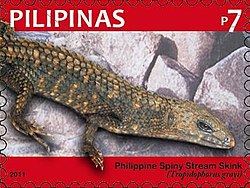Top Qs
Timeline
Chat
Perspective
Tropidophorus grayi
Species of lizard From Wikipedia, the free encyclopedia
Remove ads
Tropidophorus grayi, commonly called the spiny waterside skink,[1] Gray's keeled skink, Gray's water skink, and the Philippine spiny stream skink is a relatively abundant but secretive skink species, a lizard in the family Scincidae. The species is endemic to the Philippines.
This article needs additional citations for verification. (September 2023) |
Remove ads
Habitat
The preferred natural habitats of T. grayi are forest and forest streams, at altitudes from sea level to 800 m (2,600 ft), but it has also been found in agricultural areas adjacent to forest.[1]T. grayi lives by rivers and lakes,[citation needed] which gives it the common name waterside skink. Despite the warm climate in its native habitat, it prefers relatively cool temperatures in mountainous areas.[citation needed].
Remove ads
Description
T. grayi has serrated scales (very spiky) which are grey-black in colour, but may also appear in pure black, reddish-brown or wooden-brown colours.[citation needed] The belly is white with or without brown blotches and is smooth and shiny.[citation needed] This makes this species look like a miniature crocodile.
Behaviour
T. grayi is fast and agile. Despite its looks and speed, it is harmless, but it may occasionally bite hard, if handled. When threatened by predators this reptile hides in water. If left to swim in deep water, it may appear to drown, but it actually only plays dead. When removed, it may stay motionless for a few minutes and then return to its normal state. It is also an excellent climber, equipped with claws that can grip tree trunks and other wooden structures.[citation needed]
Diet
T. grayi eats worms, insects, small snails, slugs, and small fishes (if it can catch one).[citation needed]
In captivity
In captivity, it is observed that T. grayi likes to stack itself in piles, like turtles basking in the sun, and would rather stay on dry land than in water.[citation needed] It is becoming quite popular as an exotic pet due to its crocodilian appearance and cheap price in the Philippines.[citation needed]
Tail regeneration
Like almost any species in the skink family, T. grayi can regrow its tail if severed, but the replacement tail usually is shorter and has fewer spikes than the original tail. Also, the tail of T. grayi is tougher to break than the tail of most other skinks.[citation needed]
Reproduction
T. grayi is ovoviviparous.[2]
Etymology
The specific name, grayi, is in honor of British herpetologist John Edward Gray.[3]
References
Further reading
Wikiwand - on
Seamless Wikipedia browsing. On steroids.
Remove ads



